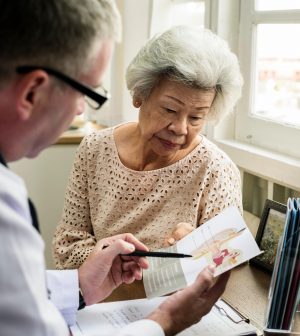- Epsom Salts: Health Benefits and Uses
- See What Saffron Can Do for Sleep and Heart Health
- 6 Common Mistakes to Avoid Before Your Physical
- Can Sweating Really Help You Beat a Cold?
- Strengthening Your Relationship: Practical Strategies
- Skip Storing This Everyday Product in the Fridge Door
- Green Tea + B3 Pairing May Boost Brain Health
- Navigating Your Midlife Crisis: Embracing New Possibilities
- City Raccoons Showing Signs of Domestication
- Mapping the Exposome: Science Broadens Focus to Environmental Disease Triggers
Language Barriers Hold Back Many Asian Americans From Good Health Care

Many Asian American and Native Hawaiian/Pacific Islander adults may have trouble accessing health care and insurance because of language barriers, a new analysis indicates.
In a new report by the Urban Institute and supported by the Robert Wood Johnson Foundation, researchers found that more than 30% of people in this group had limited English proficiency in 2019. The rate was similar to that of Hispanic adults, but with more varied languages communication may be more challenging for this group.
While most Hispanic adults in the United States speak Spanish, Asian American and Native Hawaiian/Pacific Islander (AANHPI) adults in those same circumstances speak a wide variety of languages and dialects.
“These findings show the need for greater language accessibility for this group in health care settings and when enrolling in and renewing health insurance coverage — particularly as some pandemic-related health coverage protections expire,” said Jennifer Haley, a senior research associate at the Urban Institute.
Haley noted that the White House Advisory Commission on Asian Americans, Native Hawaiians and Pacific Islanders is considering recommendations on accessibility for those in this community with limited English proficiency.
“Despite stereotypes of some AANHPI people being a ‘model minority’ and not facing disadvantages, many in this community face several barriers that could reduce their access to health insurance,” Haley said in a Robert Wood Johnson news release.
Other findings include that 15% of Asian American adults live in a household in which all members ages 14 and older report limited English proficiency.
Rates of limited English proficiency vary among different AANHPI subgroups. For example, those rates are about 12% for Native Hawaiian/Pacific Islander adults, yet much higher, at 40%, for Chinese, Bangladeshi, Vietnamese, Nepalese and Burmese adults.
Those who have limited English proficiency are more likely not to be U.S. citizens and to have lower incomes, less education and higher insurance rates than those proficient in English, the analysis found.
“As health care systems identify and work to address systemic drivers of racial inequity, it’s clear that resources must be culturally appropriate and linguistically responsive to improve access to coverage and care for individuals with limited English proficiency,” said Gina Hijjawi, senior program officer at the Robert Wood Johnson Foundation.
“State and federal officials must develop and target culturally and linguistically responsive resources to ensure that more people, including those with [limited English proficiency] have the opportunity to improve their health and the health of their communities,” Hijjawi said in the release.
More information
KFF has more on disparities in health and health care.
SOURCE: Robert Wood Johnson Foundation, news release, Dec. 13, 2022
Source: HealthDay
Copyright © 2025 HealthDay. All rights reserved.










